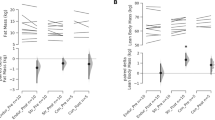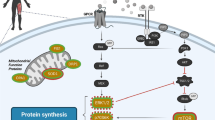Abstract
Resistance training is recommended by national health organizations for incorporation into a comprehensive fitness program that includes aerobic and flexibility exercise. Its potential benefits on health and performance are numerous; it has been shown to reduce body fat, increase basal metabolic rate, decrease blood pressure and the cardiovascular demands to exercise, improve blood lipid profiles, glucose tolerance, and insulin sensitivity, increase muscle and connective tissue cross-sectional area, improve functional capacity, and relieve low back pain. Many improvements in physical function and athletic performance are associated with the increases in muscle strength, power, endurance, and hypertrophy observed during resistance training. The key element to effective resistance training is supervision by a qualified professional and the proper prescription of the program variables. Proper program design, ie, that which uses progressive overload, variation, and specificity, is essential to maximize the benefits associated with resistance training.
Similar content being viewed by others
References and Recommended Reading
American College of Sports Medicine: Progression models in resistance training for healthy adults. Med Sci Sports Exerc 2002, 34:364–380. Provides recommendations for resistance training progression.
Feigenbaum MS, Pollock ML: Prescription of resistance training for health and disease. Med Sci Sports Exerc 1999, 31:38–45.
Kraemer WJ, Ratamess NA: Physiology of resistance training: current issues. In Orthopaedic Physical Therapy Clinics of North America: Exercise Technologies. Philadelphia: WB Saunders; 2000:467–513. This paper provides a comprehensive review of the acute responses and chronic adaptations to resistance training, as well as changes in muscular performance.
Mazzetti SA, Kraemer WJ, Volek JS, et al.: The influence of direct supervision of resistance training on strength performance. Med Sci Sports Exerc 2000, 32:1175–1184. Demonstrates the benefits of direct supervision on performance increases during resistance training.
Dudley GA, Tesch PA, Miller BJ, Buchanan MD: Importance of eccentric actions in performance adaptations to resistance training. Aviat Space Environ Med 1991, 62:543–550.
Dudley GA, Tesch PA, Harris RT, et al.: Influence of eccentric actions on the metabolic cost of resistance exercise. Aviat Space Environ Med 1991, 62:678–682.
Bandy WD, Hanten WP: Changes in torque and electromyographic activity of the quadriceps femoris muscles following isometric training. Phys Therapy 1993, 73:455–467.
Häkkinen K, Pakarinen A, Alen M, Komi PV: Serum hormones during prolonged training of neuromuscular performance. Eur J Appl Physiol 1985, 53:287–293.
Stone MH, Potteiger JA, Pierce KC, et al.: Comparison of the effects of three different weight-training programs on the one repetition maximum squat. J Strength Cond Res 2000, 14:332–337.
Häkkinen K, Komi PV, Alen M, Kauhanen H: EMG, muscle fibre and force production characteristics during a 1 year training period in elite weightlifters. Eur J Appl Physiol 1987, 56:419–427.
Evans WJ: Reversing sarcopenia: how weight training can build strength and vitality. Geriatrics 1996, 51:46–47, 51–53.
Kelley GA, Kelley KS: Progressive resistance exercise and resting blood pressure: a meta-analysis of randomized controlled trials. Hypertension 2000, 35:838–843.
Pollock ML, Franklin BA, Balady GJ, et al.: Resistance exercise in individuals with and without cardiovascular disease: benefits, rationale, safety, and prescription. Circulation 2000, 101:828–833. A position stand recommended by the ACSM, American Heart Association, Committee on Exercise, Rehabilitation, and Prevention, and Council on Clinical Cardiology for the use of resistance training in individuals with cardiovascular disease.
Clyman B: Exercise in the treatment of osteoarthritis. Curr Rheumatol Rep 2001, 3:520–523.
Mazzeo RS, Tanaka H: Exercise prescription for the elderly: current recommendations. Sports Med 2001, 31:809–818.
Storer TW: Exercise in chronic pulmonary disease: resistance exercise prescription. Med Sci Sports Exerc 2001, 33:S680-S692.
Ansved T: Muscle training in muscular dystrophies. Acta Physiol Scand 2001, 171:359–366.
Hurley BF, Roth SM: Strength training in the elderly: effects on risk factors for age-related disease. Sports Med 2000, 30:249–268.
Yarasheski KE, Pak-Loduca J, Hasten DL, et al.: Resistance exercise training increases mixed muscle protein synthesis rate in frail women and men _ 76 yr old. Am J Physiol 1999, 277:E118-E125.
Charette SL, McEvoy L, Pyka G, et al.: Muscle hypertrophy response to resistance training in older women. J Appl Physiol 1991, 70:1912–1916.
Häkkinen K, Kallinen M, Izquierdo M, et al.: Changes in agonist-antagonist EMG, muscle CSA, and force during strength training in middle-aged and older people. J Appl Physiol 1998, 84:1341–1349.
Brochu M, Savage P, Lee M, et al.: Effects of resistance training on physical function in older disabled women with coronary heart disease. J Appl Physiol 2002, 92:672–678.
Williams PT: Health effects resulting from exercise versus those from body fat loss. Med Sci Sports Exerc 2001, 33:S611-S621.
Fleck SJ, Kraemer WJ: Designing Resistance Training Programs, edn 2. Champaign, IL: Human Kinetics Books; 1997.
Van EttenLM, Westerterp KR, Verstappen FT, et al.: Effect of an 18-wk weight-training program on energy expenditure and physical activity. J Appl Physiol 1997, 82:298–304.
Kelley GA, Kelley KS: Progressive resistance exercise and resting blood pressure: a meta-analysis of randomized controlled trials. Hypertension 2000, 35:838–843.
Cuppers HJ, Erdmann D, Schubert H, et al.: Glucose tolerance, serum insulin, and serum lipids in athletes. Curr Probl Clin Biochem 1982, 11:155–165.
Giada F, Zuliani G, Baldo-Enzi G, et al.: Lipoprotein profile, diet and body composition in athletes practicing mixed anaerobic activities. J Sports Med Phys Fitness 1996, 36:211–216.
Layne JE, Nelson ME: The effects of progressive resistance training on bone density: a review. Med Sci Sports Exerc 1999, 31:25–30.
Vincent KR, Braith RW: Resistance exercise and bone turnover in elderly men and women. Med Sci Sports Exerc 2002, 34:17–23.
American College of Sports Medicine: Position stand: exercise and type 2 diabetes. Med Sci Sports Exerc 2000, 32:1345–1360.
Carpenter DM, Nelson BW: Low back strengthening for the prevention and treatment of low back pain. Med Sci Sports Exerc 1999, 31:18–24.
Hides JA, Richardson CA, Jull GA: Multifidus muscle recovery is not automatic after resolution of acute, first-episode low back pain. Spine 1996, 21:2763–2769.
Weiss A, Suzuki T, Bean J, Fielding RA: High intensity strength training improves strength and functional performance after stroke. Am J Phys Med Rehabil 2000, 79:369–376.
Staron RS, Karapondo DL, Kraemer WJ, et al.: Skeletal muscle adaptations during early phase of heavy-resistance training in men and women. J Appl Physiol 1994, 76:1247–1255.
Biolo G, Tipton KD, Klein S, Wolfe RR: An abundant supply of amino acids enhances the metabolic effect of exercise on muscle protein. Am J Physiol Endocrinol Metab 1997, 273:E122-E129.
Kraemer WJ, Gordon SE, Fleck SJ, et al.: Endogenous anabolic hormonal and growth factor responses to heavy resistance exercise in males and females. Int J Sports Med 1991, 12:228–235.
Kraemer WJ, Marchitelli L, Gordon SE, et al.: Hormonal and growth factor responses to heavy resistance exercise protocols. J Appl Physiol 1990, 69:1442–1450.
Kadi F, Bonnerud P, Eriksson A, Thornell LE: The expression of androgen receptors in human neck and limb muscles: effects of training and self-administration of androgenic-anabolic steroids. Histochem Cell Biol 2000, 113:25–29.
Häkkinen K, Komi PV: The effect of explosive type strength training on electromyographic and force production characteristics of leg extensor muscles during concentric and various stretch-shortening cycle exercises. Scand J Sports Sci 1985, 7:65–76.
Newton RU, Kraemer WJ, Häkkinen K: Short-term ballistic resistance training in the pre-season preparation of elite volleyball players. Med Sci Sports Exerc 1999, 31:323–330.
Marx JO, Ratamess NA, Nindl BC, et al.: The effects of single-set vs. periodized multiple-set resistance training on muscular performance and hormonal concentrations in women. Med Sci Sports Exerc 2001, 33:635–643.
Barbosa AR, Santarem JM, Filho WJ, Marucci MdeF: Effects of resistance training on the sit-and-reach test in elderly women. Strength Cond Res 2002, 16:14–18.
Behm DG, Button DC, Butt JC: Factors affecting force loss with prolonged stretching. Can J Appl Physiol 2001, 26:262–272.
Tesch PA: Short- and long-term histochemical and biochemical adaptations in muscle. In Strength and Power in Sport. Boston: Blackwell Scientific Publications; 1992:239–248.
Gettman LR, Culter LA, Strathman T: Physiological changes after 20 weeks of isotonic vs isokinetic circuit training. J Sports Med Phys Fitness 1980, 20:265–274.
Author information
Authors and Affiliations
Rights and permissions
About this article
Cite this article
Kraemer, W.J., Ratamess, N.A. & French, D.N. Resistance training for health and performance. Curr Sports Med Rep 1, 165–171 (2002). https://doi.org/10.1007/s11932-002-0017-7
Published:
Issue Date:
DOI: https://doi.org/10.1007/s11932-002-0017-7




